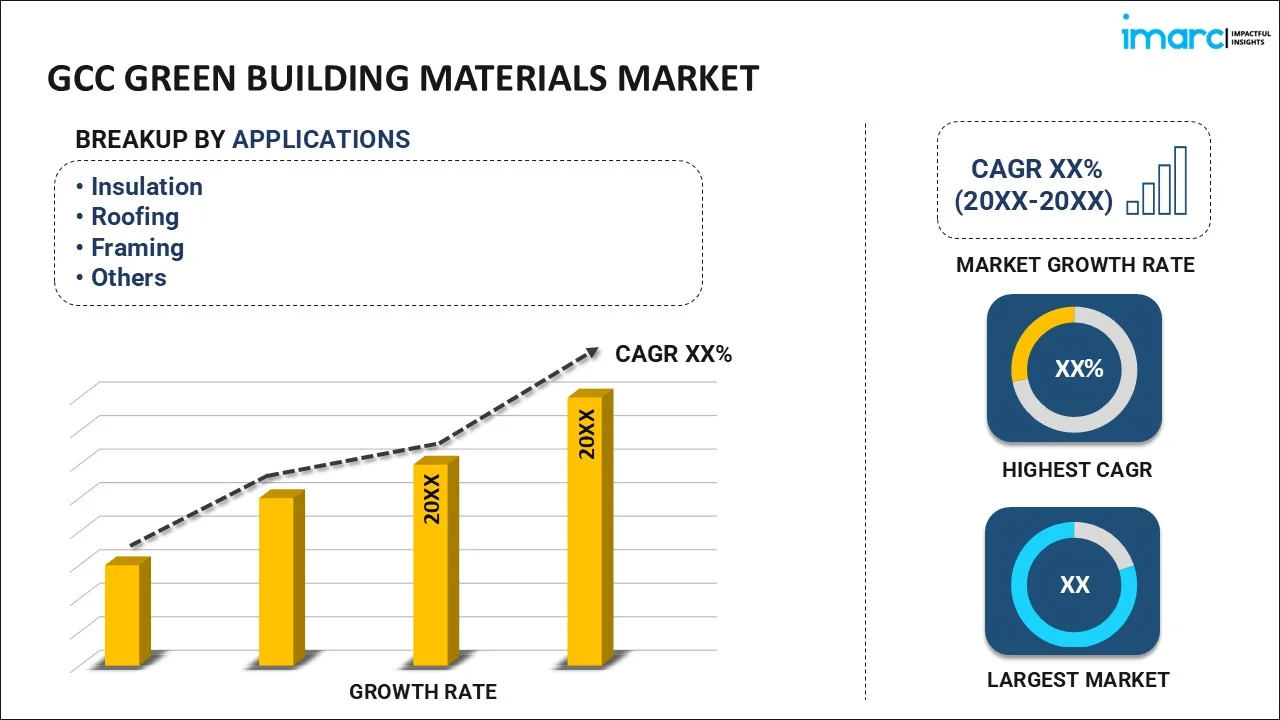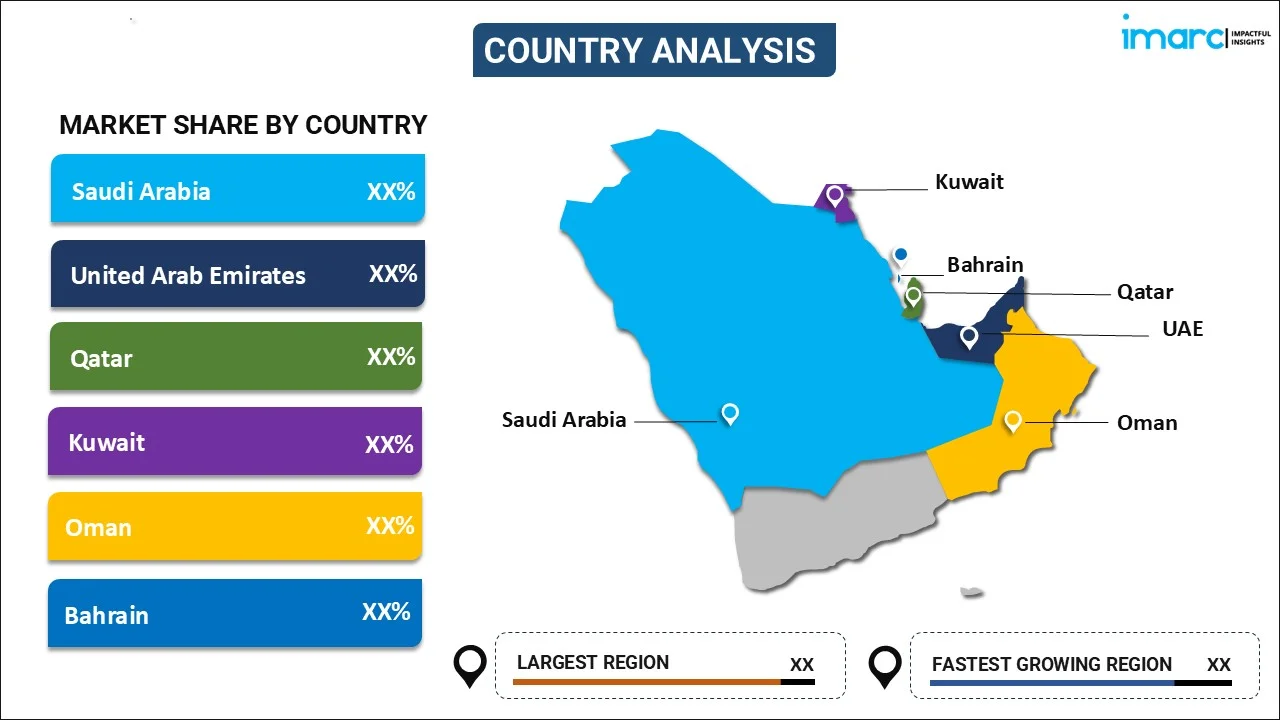
GCC Green Building Materials Market Report by Application (Insulation, Roofing, Framing, Interior Finishing, Exterior Siding, and Others), and Country 2025-2033
GCC Green Building Materials Market:
GCC green building materials market size reached USD 10.6 Billion in 2024. Looking forward, IMARC Group expects the market to reach USD 28.8 Billion by 2033, exhibiting a growth rate (CAGR) of 10.7% during 2025-2033. The increasing awareness towards environmental sustainability and the growing eco-friendly options are catalyzing the market.
|
Report Attribute
|
Key Statistics
|
|---|---|
|
Base Year
|
2024
|
|
Forecast Years
|
2025-2033
|
|
Historical Years
|
2019-2024
|
|
Market Size in 2024
|
USD 10.6 Billion |
|
Market Forecast in 2033
|
USD 28.8 Billion |
| Market Growth Rate 2025-2033 | 10.7% |
GCC Green Building Materials Market Analysis:
- Major Market Drivers: As urban areas expand, there is a greater focus on using green materials in Saudi Arabia and Qatar that support environmental goals and enhance the quality of living spaces, which is driving the market growth.
- Key Market Trends: The elevating demand for recycled materials, numerous smart technologies, and the increasing number of LEED-certified projects in the United Arab Emirates are positively influencing the market.
- Competitive Landscape: The report has also provided a comprehensive analysis of the competitive landscape in the market. Also, detailed profiles of all major companies have been provided.
- Geographical Trends: According to the GCC green building market outlook, Saudi Arabia and the United Arab Emirates see growing demand for green building materials due to sustainable development goals. In contrast, Qatar emphasizes eco-friendly infrastructure, while Kuwait, Oman, and Bahrain focus on energy-efficient construction, promoting green materials to adapt to unique climate conditions and environmental regulations.
- Challenges and Opportunities: The high costs and the restricted availability of sustainable options are hampering the market growth. However, enhancing government incentives, boosting local production, and increasing awareness of the long-term benefits of green building practices will continue to bolster the market over the forecasted period.
GCC Green Building Materials Market Trends:
Increasing Demand for Sustainable Construction Solutions
The GCC region is experiencing a growing demand for sustainable construction solutions as it focuses on reducing carbon emissions and enhancing energy efficiency. This shift is driven by environmental concerns, regulatory changes, and the desire for long-term cost savings, prompting the adoption of green building materials and technologies in construction projects across the region. For example, in July 2024, Green Valley Biochar and Bton Group partnered to integrate biochar into concrete production in the GCC. This initiative aims to enhance concrete durability and support net-zero goals, promoting sustainable construction and innovative green building materials across the region.
Technological Advancements in Construction Practices
Technological advancements in construction practices are revolutionizing the GCC region, driving the adoption of innovative solutions that enhance building efficiency and sustainability. The integration of cutting-edge technologies, such as digital modeling and advanced construction methods, supports the shift towards greener construction, reduces environmental impact, and aligns with the region’s sustainability goals and vision for future development. For example, in May 2024, Trimble announced its advanced construction technology solutions aimed at transforming the GCC construction industry ahead of Riyadh Expo 2030. This initiative supports the region’s shift towards sustainable building practices by integrating innovative technologies into green construction projects.
Government Initiatives for Sustainable Development
Government initiatives in the GCC region are increasingly focused on promoting sustainable development through regulations and incentives that encourage green building practices. Countries like the UAE and Saudi Arabia are implementing stricter environmental standards and providing financial support for eco-friendly projects, aiming to reduce carbon footprints and foster a more sustainable construction landscape across the region. For instance, in April 2024, One Click LCA partnered with Grey Matters as the exclusive reseller of EPD generation solutions in the GCC, aligning with government initiatives promoting sustainable development. This collaboration supports regional efforts to meet environmental standards and encourages the use of green building materials in the GCC’s expanding construction sector.
GCC Green Building Materials Industry Segmentation
IMARC Group provides an analysis of the key trends in each segment of the market, along with the forecasts at the regional and country levels for the period 2025-2033. Our report has categorized the market based on the application.
Breakup by Application:

- Insulation
- Roofing
- Framing
- Interior Finishing
- Exterior Siding
- Others
The report has provided a detailed breakup and analysis of the market based on the application. This includes insulation, roofing, framing, interior finishing, exterior siding, and others.
Green building materials are transforming the construction industry by providing sustainable alternatives for various applications. In contrast, insulation materials like cellulose and recycled cotton help improve energy efficiency by reducing heat transfer. For roofing, eco-friendly options, such as cool roofs and green roofs, minimize heat absorption and support biodiversity. Apart from this, sustainable framing materials, including bamboo and recycled steel, reduce resource depletion while enhancing durability. Interior finishing materials, such as low-VOC paints and reclaimed wood, improve indoor air quality and reduce environmental impact. In addition, Exterior siding options like fiber cement and recycled metal offer durability and weather resistance, further escalating the GCC green building materials market share.
Breakup by Country:

- Saudi Arabia
- United Arab Emirates
- Qatar
- Kuwait
- Oman
- Bahrain
The report has also provided a comprehensive analysis of all the major regional markets, which include Saudi Arabia, the United Arab Emirates, Qatar, Kuwait, Oman, and Bahrain.
According to the GCC green building materials market forecast, the market is shaped by regional climate, economic growth, and government policies. The UAE and Saudi Arabia are leading with substantial investments in sustainable construction, driven by their ambitious climate goals. In contrast, other GCC countries, like Qatar and Oman, are also embracing green building initiatives, focusing on energy efficiency and reducing environmental footprints. Consequently, urbanization and infrastructure development across the region further fuel the demand for eco-friendly materials as cities aim to enhance sustainability and resilience against extreme weather conditions. This trend reflects a broader regional shift toward sustainable development.
Competitive Landscape:
The market research report has also provided a comprehensive analysis of the competitive landscape in the market. Competitive analysis, such as market structure, key player positioning, top winning strategies, competitive dashboard, and company evaluation quadrant, has been covered in the report. Also, detailed profiles of all major companies have been provided.
GCC Green Building Materials Market Recent Developments:
- July 2024: Green Valley Biochar and Bton Group partnered to integrate biochar into concrete production in the GCC. This initiative aims to enhance concrete durability and support net-zero goals, promoting sustainable construction and innovative green building materials across the region.
- April 2024: One Click LCA partnered with Grey Matters to become the exclusive reseller of EPD generation solutions in the GCC. This development aims to advance sustainable construction practices and promote green building materials in the region.
- April 2024: Building DMCC reported a 40% increase in demand for airtightness testing in the GCC. This rise reflects the region's growing focus on energy-efficient and sustainable building practices, driven by efforts to mitigate climate change and enhance building resilience.
GCC Green Building Materials Market Research Report:
| Report Features | Details |
|---|---|
| Base Year of the Analysis | 2024 |
| Historical Period | 2019-2024 |
| Forecast Period | 2025-2033 |
| Units | Billion USD |
| Scope of the Report | Exploration of Historical Trends and Market Outlook, Industry Catalysts and Challenges, Segment-Wise Historical and Predictive Market Assessment:
|
| Applications Covered | Insulation, Roofing, Framing, Interior Finishing, Exterior Siding, Others |
| Countries Covered | Saudi Arabia, United Arab Emirates, Qatar, Kuwait, Oman, Bahrain |
| Customization Scope | 10% Free Customization |
| Post-Sale Analyst Support | 10-12 Weeks |
| Delivery Format | PDF and Excel through Email (We can also provide the editable version of the report in PPT/Word format on special request) |
Key Questions Answered in This Report:
- How has the GCC green building materials market performed so far, and how will it perform in the coming years?
- What has been the impact of COVID-19 on the GCC green building materials market growth?
- What is the breakup of the GCC green building materials market on the basis of application?
- What are the various stages in the value chain of the GCC green building materials market?
- What are the key driving factors and challenges in the GCC green building materials?
- What is the structure of the GCC green building materials market, and who are the key players?
- What is the degree of competition in the GCC green building materials market?
Key Benefits for Stakeholders:
- IMARC’s industry report offers a comprehensive quantitative analysis of various market segments, historical and current market trends, market forecasts, and dynamics of the GCC green building materials market from 2019-2033.
- The research report provides the latest information on the market drivers, challenges, and opportunities in the GCC green building materials market.
- The study maps the leading, as well as the fastest-growing, markets. It further enables stakeholders to identify the key country-level markets within the region.
- Porter's five forces analysis assists stakeholders in assessing the impact of new entrants, competitive rivalry, supplier power, buyer power, and the threat of substitution. It helps stakeholders to analyze the level of competition within the GCC green building materials industry and its attractiveness.
- The competitive landscape allows stakeholders to understand their competitive environment and provides insight into the current positions of key players in the market.
Need more help?
- Speak to our experienced analysts for insights on the current market scenarios.
- Include additional segments and countries to customize the report as per your requirement.
- Gain an unparalleled competitive advantage in your domain by understanding how to utilize the report and positively impacting your operations and revenue.
- For further assistance, please connect with our analysts.
 Inquire Before Buying
Inquire Before Buying
 Speak to an Analyst
Speak to an Analyst
 Request Brochure
Request Brochure
 Request Customization
Request Customization




.webp)




.webp)












